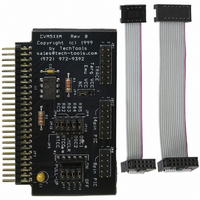2/21/00
The CVM5XXM Member module emulates the 14-pin PIC16C505 and the 8-pin PIC12C508,
PIC12C509, PIC12CE518, and PIC12CE519 micro-controllers. These devices are part of the 12
bit PICmicro family and therefore requires the 5X FAMILY module (CVM5XF) for operation.
The PIC12CE518 and PIC12CE519 devices have EEPROM support.
EMULATOR DISCREPENCIES:
Due to BONDOUT limitations, the following features are either NOT SUPPORTED or are
modified slightly:
! The Wake-Up on pin change feature is not supported. The GPWU bit (OPTION.7) has no
! The “weak pull-up” resistors are enabled/disabled by hardware jumpers on the member pod
! Mathias provides the operating clock so the OSCCAL register has no affect. You can
! GP3 is an INPUT ONLY on the real device to accommodate that pin’s alternative use as
! In an actual device, setting the TOCS bit (OPTION.5) automatically forces GP2 to be an
! In an actual device, GPIO bits 6 and 7 are not implemented and will always read back ‘0’. In
! EEPROM support for PIC12CE518 and PIC12CE519 devices are available on RA0 for SDA
EMULATOR CABLES:
Attach the cable for 8-pin devices to JP8. The cable for 14-pin devices should be attached to
JP13.
affect. And the corresponding flag GPWUF (STATUS.7) has no meaning.
rather than through the GPPU bit (OPTION.6). This bit has no affect.
program Mathias for any clock frequency between 30KHz and 20MHz. The real PIC devices
run at around 4 MHz from their internal oscillator.
MCLR. The emulator provides a full INPUT/OUTPUT pin for this function. The MCLR
signal is brought into the bondout chip through a different connection. You should
ALWAYS SET the corresponding TRIS bit for GP3 to properly emulate this INPUT-ONLY
behavior.
input, over-riding the TRIS bit for GP2. The emulator DOES NOT automatically force GP2
to be an input. YOU MUST SET TRIS.2 YOURSELF, if you use GP2 as a T0CS input.
the emulator, these bits are actually present and will read back whatever was last written to
them if the corresponding TRIS bits are cleared. If these TRIS bits are SET, then these bits
read FLOATING inputs and their value is indeterminate.
(versus GPIO reg, bit 6 on an actual device) and RA1 for SCL (versus GPIO reg. bit 7 on an
actual device)
CVM5XXM User’s Guide
PO Box 462101 Garland, TX 75046-2101
Voice: (972) 272-9392 FAX: (972) 494-5814
www.tech-tools.com sales@tech-tools.com

















